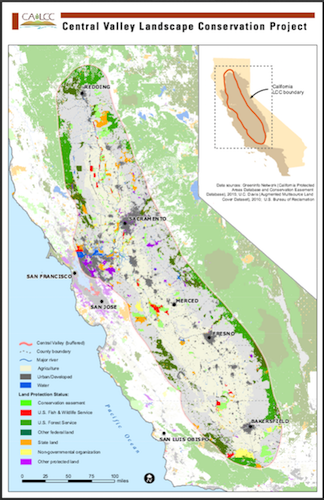Central Valley LCP: Reading Materials for the Adaptation Strategies Workshop
This material has been compiled for reading prior to the Central Valley Adaptation Strategies Workshop on May 10-11, 2016. We hope you find it both informative and inspiring!
| Required Reading | |||
|
|
An Ecologically-connected Central Valley Landscape The overarching goal of the Central Valley Landscape Conservation Project is an "ecologically-connected landscape". We are working toward this goal as a partnership by evaluating and responding to the impacts of climate change and other human-driven stressors with climate-smart adaptation strategies and actions implemented in a coordinated fashion across the landscape. Scan this Quick Guide to Climate-Smart Conservation to see the rationale behind our process and the context for our Adaptation Strategies and Actions Workshop. Developing Adaptation Strategies and Actions Adaptation refers to the ability to modify one's life-strategy to cope with or avoid stressors. Climate-smart conservation adaptation strategies and actions explicitly address components of vulnerability of the conservation target, whether at the species or habitat level or in landscape adaptation strategies, at the landscape scale and across future scenarios. We will work on developing both in our up-coming workshop. Reference Sheet: Strategic Methods for Identifying Adaptation Strategies |
||
| Additional Reading (helpful but not required) |
About Landscape Conservation Designs
Chapter 8: "The Art of the Possible: Identifying Adaptation Options"
From: Stein, B. A., P. Glick, N. Edelson, and A. Staudt. 2014. Climate-Smart Conservation: Putting Adaptation Principles into Practice. National Wildlife Federation.
Preparing for and managing change: climate adaptation for biodiversity and ecosystems
Stein, B. A., A. Staudt, M. S. Cross, N. S. Dubois, C. Enquist, R. Griffis, L. J. Hansen, J. J. Hellmann, J. J. Lawler, E. J. Nelson, and A. Pairis. 2013. Frontiers in Ecology and the Environment 11:502–510. (Access provided for workshop attendees.)
Incorporating climate change into systematic conservation planning.
Groves, C. R., E. T. Game, M. G. Anderson, M. Cross, C. Enquist, Z. Ferdaña, E. Girvetz, A. Gondor, K. R. Hall, J. Higgins, R. Marshall, K. Popper, S. Schill, and S. L. Shafer. 2012. Biodiversity and Conservation 21:1651–1671.
Adapting California’s Ecosystems to a Changing Climate.
Chornesky, E. A., D. D. Ackerly, P. Beier, F. W. Davis, L. E. Flint, J. J. Lawler, P. B. Moyle, M. A. Moritz, M. Scoonover, K. Byrd, P. Alvarez, N. E. Heller, E. R. Micheli, and S. B. Weiss. 2015. BioScience:biu233.
(See especially "Box 2: Operating principles for adapting California ecosystems to climate change")
Listing of titles on the topic from the Climate Commons: "Climate change adaptation" and "Adaptation planning".


